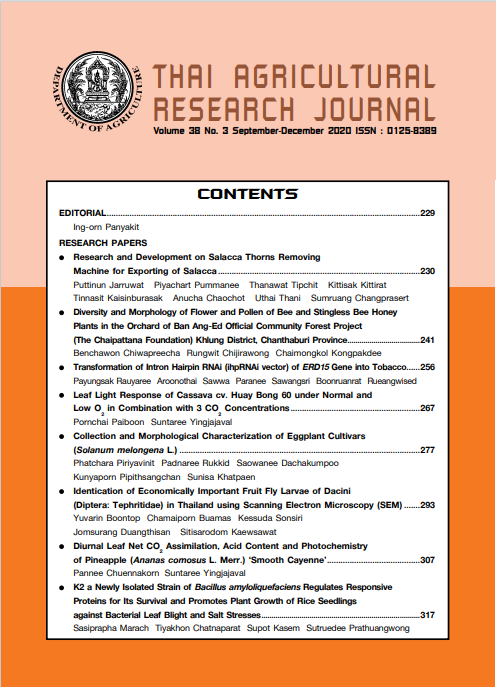Diversity and Morphology of Flower and Pollen of Bee and Stingless bee Honey Plants in the Orchard of Ban Ang-Ed Official Community Forest Project (The Chaipattana Foundation) Khlung District, Chanthaburi Province
DOI:
https://doi.org/10.14456/thaidoa-agres.2020.18Keywords:
bee flora, stingless bee, pollen, pollinatorAbstract
The study of diversity and morphology of honey plants’ flower and pollen of bee and stingless bee was carried out at Ban Ang-Ed Official Community Forest (The Chaipattana Foundation), Chanthaburi Province from March 2016 to January 2017. The objectives were to study speciesdiversity, floral and pollen characteristics of bee and stingless bee’s honey plants. A total of 11 families 17 genera and 18 species of honey plants were found. The all season blooming plants were herbaceous weeds, shrubs and shrubby trees including Asystasia gangetica subsp. micrantha, Ageratum conyzoides, Chromolaena odorata, Merremia umbellate, Acacia megaladena var. indo-chinensis, Crotalaria juncea, Mimosa pigra, Saraca declinata, Senna siamea, Syzygium siamense, Aidia wallichiana, Paederia foetida, Citrus aurantifolia, C. japonica, Zollingeria dongnaiensis, Helicteres hirsuta, Congea tomentosa and Ampelocissus martinii. Floral characteristics most attractive to bee and stingless bee were white color and brush form. The eighteen pollen samples which bee and stingless bee collected were of different characters, most of them (61.11%) were small (10-24 μm). Therefore, differences of pollen characteristics could be useful in predicting the plant species that honey and bee pollen were collected. Results also indicated that some weeds and local plants in the orchard can be a food source for bee and stingless bee throughout the year.
References
กรมส่งเสริมการเกษตร. 2560. ลักษณะของผึ้งและชีวิตสังคมของผึ้ง. แหล่งข้อมูล : www.agriman.doae.go.th/beegroup/bee3.htm. ค้นเมื่อ 2 พฤษภาคม. 2560.
ธัชคณิน จงจิตวิมล และสหณัฐ เพชรศรี. 2558. รายงานวิจัยฉบับสมบูรณ์ ละอองเรณูพืชอาหารของแมลงผสมเกสรในวงศ์ Apidae (Hymenoptera) ในพื้นที่อุทยานแห่งชาติภูหินร่องกล้า จังหวัดพิษณุโลก. ประจำปีงบประมาณ 2557. คณะวิทยาศาสตร์และเทคโนโลยี มหาวิทยาลัยราชภัฏพิบูลสงคราม, พิษณุโลก. 73 หน้า.
ประนอม จันทรโณทัย และพันธ์ทิวา กระจาย. 2555. เรณูของพืชดอก. โรงพิมพ์คลังนานาวิทยา, ขอนแก่น. 87 หน้า.
ปิยะมาศ นานอก โสภาลดาวัลย์ และจิราพร สอนโยหา. 2560. ชนิดของพืชอาหารจากก้อนเรณูของชันโรง (Trigona laeviceps Smith) ในพื้นที่ศูนย์ส่งเสริมและพัฒนาอาชัพการเกษตร จังหวัดขอนแก่น. หน้า 618-629. ใน : การประชุมวิชาการมหาวิทยาลัยมหาสารคามวิจัย ครั้งที่ 13. 7-8 กันยายน 2560 ณ มหาวิทยาลัยมหาสารคาม.
ราชบัณฑิตยสถาน. 2541. ศัพท์พฤกษศาสตร์ อังกฤษ-ไทย ฉบับราชบัณฑิตยสถาน. หจก.อรุณการพิมพ์, กรุงเทพฯ. 331 หน้า.
สัมฤทธิ์ มากสง. 2560. ความหลากหลายของพืชอาหารของผึ้งในหมู่บ้านทิพุเย ตำบลชะแล อำเภอทองผาภูมิ จังหวัดกาญจนบุรี. วารสารวิทยาศาสตร์และเทคโนโลยี. 24(1): 76-86.
สันติ สุขสะอาด และอนันตชัย ศรีทอง. 2559. การตลาดและการวิเคราะห์ทางการเงินของการเลี้ยงชันโรงในจังหวัดจันทบุรี. ว.วนศาสตร์. 36(2): 67-76.
ส่วนพฤกษศาสตร์ป่าไม้ กรมป่าไม้. 2557. ชื่อพรรณไม้แห่งประเทศไทย เต็ม สมิตินันทน์. ฉบับแก้ไขเพิ่มเติม พ.ศ. 2557. โรงพิมพ์สำนักงานพระพุทธศาสนาแห่งชาติ, กรุงเทพฯ. 807 หน้า.
สุวคนธ์ โคตรมี. 2543. ผึ้งในบทบาทของการเป็นแมลงช่วยผสมเกสร. ว.กีฎและสัตววิทยา. 22(1): 63-64.
อัจนา ชำนาญศิลป์ อรสา เสนีวงศ์ ณ อยุธยา และภัทรมาศ พานพุ่ม. 2556. องค์ความรู้เพิ่มประสิทธิภาพสู่การเป็น smart officer ผึ้งและแมลงเศรษฐกิจ. โรงพิมพ์ชุมชุนสหกรณ์การเกษตรแห่งประเทศไทย จำกัด. กรุงเทพฯ. 116 หน้า.
อัญชลี สวาสดิ์ธรรม. 2556. มหัศจรรย์ชันโรง. ทริปเพิ้ล กรุ๊ป, กรุงเทพฯ. 27 หน้า.
Adhikari, S. and N.B. Ranabhat. 2011. Bee flora in mid hills of central Nepal. J. Plant Sci. 8: 45-56.
Andrew, G.S.C. and M.A. Brown. 2006. Vital pollinators: honey bees in apple orchards. Biologist. 53(2): 78-81.
Bilisik, A., I. Cakmak, A. Bicakci and H. Malyer. 2008. Seasonal variation of collected pollen loads of honeybees (Apis mellifera L. anatoliaca). Grana. 47: 70-77.
Denisow, B. and M. Wrzesien. 2015. The importance of field margin location for maintenance of food niches for pollinators. J. Apic Sci. 59(1): 27-37.
Erdtman, G. 1986. Pollen Morphology and plant Taxonomy Agiosperms (An introduction to palynology ). Hafner Publishing Company, New York. 553 p.
Harder, L.D. 1998. Pollen size comparisons among animal pollinated angiosperms with different pollination characteristics. Bot. J. the Linnean Society. 64: 513-525.
Karakose, M., R. Polat., O. Rahman and U. Cakilcioglu. 2018. Traditional honey production and bee flora of Espiye, Turkey. Bangladesh J. Plant Taxon. 25(1): 79-91.
Klein, A.M., B.E. Vaissiere, J.H. Cane, I.S. Dewenter, S.A. Cunningham, C. Kremen and T. Tscharntke. 2006. Importance of pollinators in changing landscapes for world crops. The Royal Society. 274: 303-313.
Momose, K., T. Yumoto, T. Nagamitsu, M. Kato, H. Nakamasu, S. Sakai, R.D. Harrison, T. Itioka, A.A. Hamid,and T. Inoue. 1998. Pollination biology in a lowland dipterocarp forest in Sarawak, Malaysia. . Characteristics of the plant-pollinator community in a lowland dipterocarp forest. American J. Bot.. 85(10): 1477-1501.
Nugueira, A., L.B. Valadao-Mendes, J.H.L. El Ottra, E. Gulmaraes, P. C. Gustavson, M. M. Quinalha, J.V. Paulino and J.G. Rando. 2018. Ralationship of floral morphology and development with the pattern of bee visitation in a species with pollen-flower, Chamaecrista desvauxii (Fabaceae). Bot. J. the Linnean Society. 187: 137-156.
Potts, S.G., J.C. Biesmeijer, C. Kremen, P. Neumann, O. Schweiger and W. E. Kunin. 2010. Global pollinator declines: trends, impacts and drivers. Trends in Bio. Evol. 25(6): 345-350.
Roopa, S.R. and V. Sivaram. 2013. Pollen moephology of selected bee forage plants. G.J.B.B. 2(1): 82-90.
Downloads
Published
How to Cite
Issue
Section
License
Thai Agricultural Research Journal



